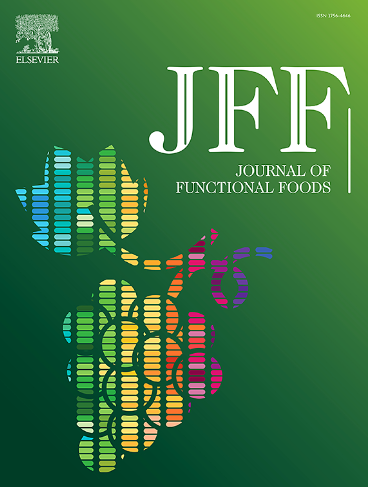源自灰树叶的 ACE 抑制肽可减轻外泌体介导的血管平滑肌细胞表型转化
IF 3.8
2区 农林科学
Q2 FOOD SCIENCE & TECHNOLOGY
引用次数: 0
摘要
Grifola frondosa 是一种高蛋白食用菌,它通过抑制 ACE 发挥潜在的降压作用。ACE 在血管平滑肌细胞(VSMC)中表达,并通过外泌体运输。这项研究通过酶水解制备了低分子量的 GFP,显示出很强的 ACE 抑制作用。Ang II 增加了血管平滑肌细胞中 ACE 的表达和活性,通过上调 α-SMA 和 OPN 诱导表型转换。GFP 降低了 Ang II 的刺激作用。经 Ang II 处理(Ang II-Exos)或 GFP 处理(GFP-Exos)的 VSMC 的外泌体粒径小于 200 nm,其生物标记物 CD63 和 Tsg101 呈阳性。共培养实验显示,ACE 负荷在 Ang II-Exos 中高于 VSMCs,但在 GFP-Exos 中则显著低于 VSMCs。Ang II-Exos 促进了 VSMC 的增殖、迁移、炎症和表型转换,而 GFP-Exos 则通过抑制 ACE 活性和调节 NF-κB 通路大大降低了这些影响。GFP 通过调节外泌体介导的 ACE 负荷和表型转换,有效缓解了 Ang II 诱导的 VSMC 功能障碍。本文章由计算机程序翻译,如有差异,请以英文原文为准。

The Grifola frondosa-derived ACE inhibitory peptide attenuated the exosomes-mediated phenotype transformation of vascular smooth muscle cells
Grifola frondosa, a high-protein edible mushroom, exhibited potential antihypertensive effects through ACE inhibition. The ACE was expressed in vascular smooth muscle cells (VSMCs) and transported via exosomes. This study prepared low molecular weight GFP through enzymatic hydrolysis, showing strong ACE inhibition. Ang II increased ACE expression and activity in VSMCs, inducing phenotype switching by up-regulating α-SMA and OPN. GFP reduced Ang II’s stimulating effects. Exosomes from Ang II-treated (Ang II-Exos) or GFP-treated (GFP-Exos) VSMCs had particle sizes under 200 nm with positive biomarkers CD63 and Tsg101. Co-culture experiments revealed higher ACE loading in Ang II-Exos than in VSMCs, but significantly lower in GFP-Exos. Ang II-Exos promoted VSMC proliferation, migration, inflammation, and phenotypic switching, while GFP-Exos significantly reduced these effects by inhibiting ACE activity and regulating the NF-κB pathway. GFP effectively mitigated Ang II-induced VSMC dysfunction by modulating exosome-mediated ACE loading and phenotypic transformation.
求助全文
通过发布文献求助,成功后即可免费获取论文全文。
去求助
来源期刊

Journal of Functional Foods
FOOD SCIENCE & TECHNOLOGY-
CiteScore
9.60
自引率
1.80%
发文量
428
审稿时长
76 days
期刊介绍:
Journal of Functional Foods continues with the same aims and scope, editorial team, submission system and rigorous peer review. We give authors the possibility to publish their top-quality papers in a well-established leading journal in the food and nutrition fields. The Journal will keep its rigorous criteria to screen high impact research addressing relevant scientific topics and performed by sound methodologies.
The Journal of Functional Foods aims to bring together the results of fundamental and applied research into healthy foods and biologically active food ingredients.
The Journal is centered in the specific area at the boundaries among food technology, nutrition and health welcoming papers having a good interdisciplinary approach. The Journal will cover the fields of plant bioactives; dietary fibre, probiotics; functional lipids; bioactive peptides; vitamins, minerals and botanicals and other dietary supplements. Nutritional and technological aspects related to the development of functional foods and beverages are of core interest to the journal. Experimental works dealing with food digestion, bioavailability of food bioactives and on the mechanisms by which foods and their components are able to modulate physiological parameters connected with disease prevention are of particular interest as well as those dealing with personalized nutrition and nutritional needs in pathological subjects.
 求助内容:
求助内容: 应助结果提醒方式:
应助结果提醒方式:


